Insulating a pole barn ceiling is an essential step in creating a comfortable and energy-efficient workspace. Pole barns are versatile structures that can be used for a variety of purposes, including storage, workshops, and even homes. However, they can be challenging to insulate due to their unique design and construction. In this article, I will share my experience and knowledge on how to insulate a pole barn ceiling to help you create a comfortable and energy-efficient space.
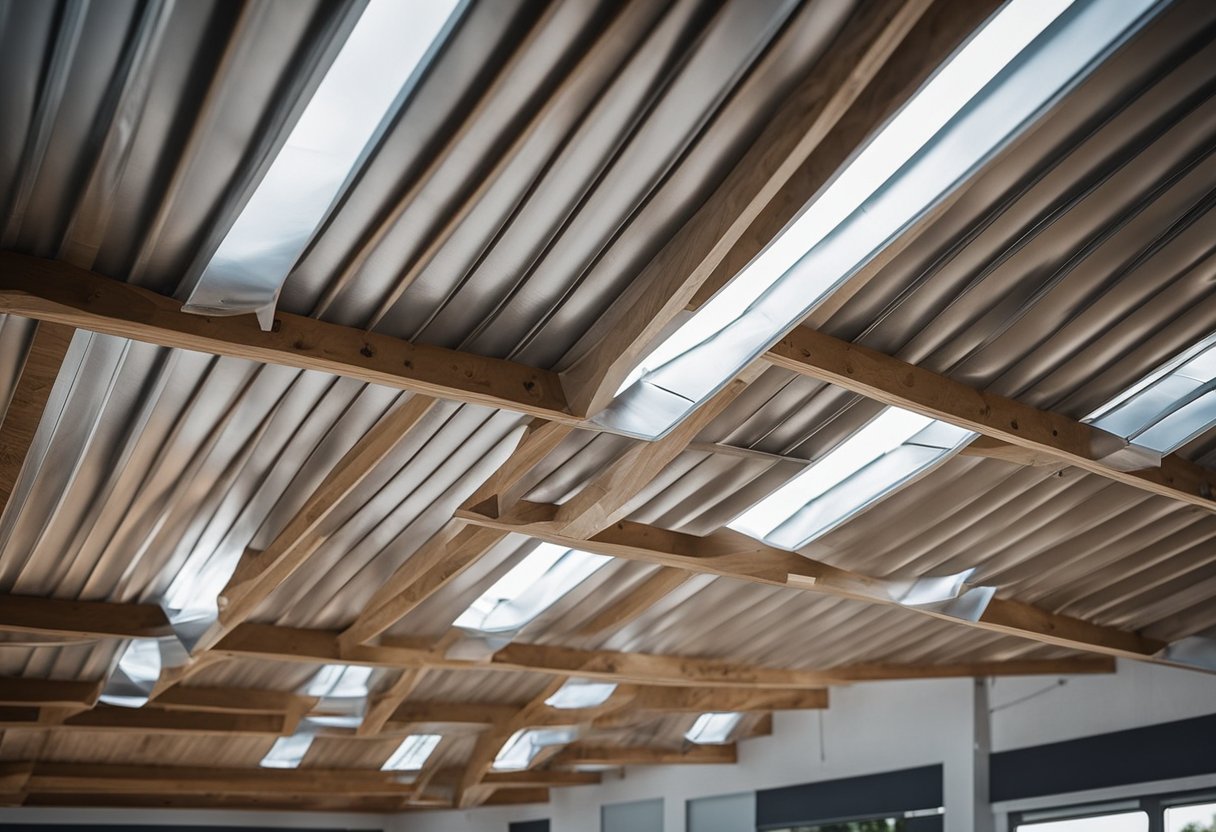
Understanding insulation basics is the first step in insulating your pole barn ceiling. Insulation works by creating a barrier between the interior and exterior of your pole barn. It helps to regulate temperature, prevent moisture buildup, and reduce noise. There are several types of insulation available, including batts and blankets, foam board, and spray foam. Choosing the right type of insulation for your pole barn ceiling will depend on several factors, including your budget, the size of your pole barn, and your climate.
Key Takeaways
- Understanding insulation basics is crucial for insulating a pole barn ceiling.
- Choosing the right type of insulation for your pole barn ceiling depends on several factors.
- Proper installation and ventilation are essential for maintaining an energy-efficient and comfortable pole barn.
Understanding Insulation Basics
Insulating your pole barn ceiling is an important step in improving its energy efficiency and making it more comfortable to use. Insulation works by slowing down the transfer of heat between the inside and outside of your pole barn, which can help keep it warmer in the winter and cooler in the summer.
When choosing an insulation material, it’s important to consider its R-value, which is a measure of its thermal resistance. The higher the R-value, the better the insulation will be at slowing down the transfer of heat. The R-value you need will depend on the climate you live in and how you plan to use your pole barn.
Some common insulation materials include fiberglass, mineral wool, and cotton batts and blankets. These materials are relatively easy to install and can provide good thermal resistance. Spray foam insulation is another option that can provide even better insulation, but it can be more expensive and difficult to install.
In addition to choosing the right insulation material, it’s important to install it correctly to maximize its effectiveness. This may involve filling gaps and cracks in the ceiling to prevent air leaks, as well as adding a vapor barrier to prevent moisture from getting trapped in the insulation.
By understanding the basics of insulation and choosing the right insulation material for your pole barn ceiling, you can improve its energy efficiency and make it more comfortable to use.
Choosing the Right Insulation for Your Pole Barn Ceiling
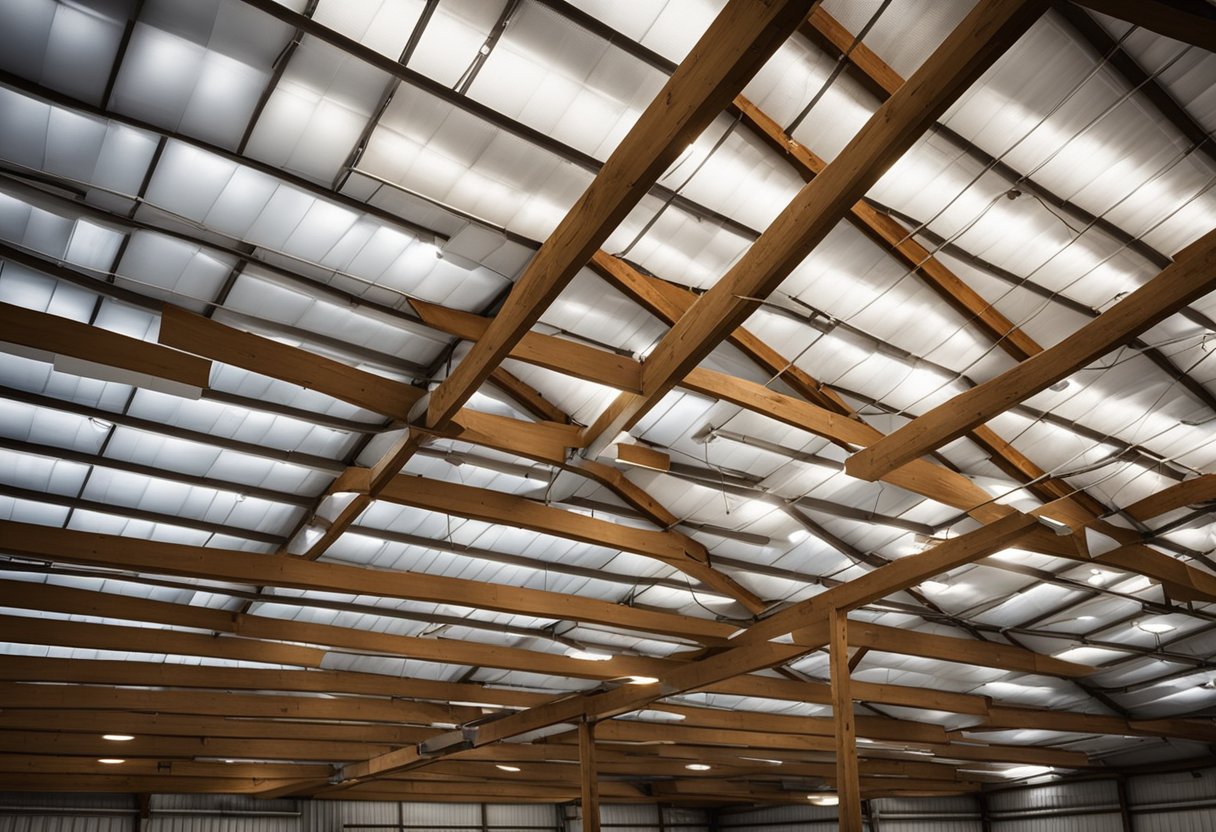
Insulating your pole barn ceiling is essential for keeping your barn warm in winter and cool in summer. It can also help reduce energy costs and prevent moisture buildup. However, choosing the right insulation for your pole barn ceiling can be tricky. Here are some factors to consider when choosing insulation for your pole barn ceiling.
R-value
The R-value measures the insulation’s ability to resist heat flow. The higher the R-value, the better the insulation’s thermal performance. The R-value you need for your pole barn ceiling depends on your climate zone. The US Department of Energy recommends an R-value of at least 30 for pole barn ceilings in most regions of the US.
Material
There are many types of insulation materials available for pole barn ceilings. Some of the most common types include:
-
Fiberglass insulation: Fiberglass insulation is made of tiny glass fibers and is one of the most popular types of insulation. It is affordable and easy to install.
-
Spray foam insulation: Spray foam insulation is a type of insulation that is sprayed into the ceiling cavity. It expands to fill all the gaps and provides an airtight seal.
-
Rigid foam insulation: Rigid foam insulation is a type of insulation that is made of polystyrene or polyurethane foam. It is lightweight and easy to install.
-
Blow-in insulation: Blow-in insulation is a type of loose-fill insulation that is blown into the ceiling cavity. It is great for hard-to-reach areas.
-
Radiant barrier insulation: Radiant barrier insulation is a type of insulation that reflects heat away from the ceiling. It is great for hot climates.
Cost
The cost of insulation varies depending on the type of insulation you choose. Fiberglass insulation is one of the most affordable types of insulation, while spray foam insulation is one of the most expensive. However, the cost of insulation should not be the only factor you consider when choosing insulation for your pole barn ceiling. You should also consider the insulation’s R-value, material, and other factors.
Overall, choosing the right insulation for your pole barn ceiling can be a daunting task. However, by considering the insulation’s R-value, material, and cost, you can make an informed decision that will keep your pole barn comfortable and energy-efficient.
The Insulation Installation Process
Now that we have gathered all the necessary tools and materials, we can proceed with the insulation installation process.
Firstly, it is important to wear protective clothing and gear such as gloves, goggles, and a mask to avoid any irritation or allergies caused by the insulation material.
Next, we need to prepare the insulation material. If you are using fiberglass insulation, you can easily cut it to the desired size using a utility knife. If you are using loose-fill insulation, you can use an insulation blower to blow the insulation material into the ceiling cavity.
Once the insulation material is prepared, we can start installing it. If you are using fiberglass insulation, you can simply place the insulation batts between the ceiling joists, making sure to fill any gaps or spaces. You can use a staple gun to secure the insulation in place.
If you are using loose-fill insulation, you can use a blower to blow the insulation material into the ceiling cavity. Make sure to fill all the gaps and spaces and avoid overfilling the cavity.
After the insulation is installed, we need to seal any gaps or spaces to prevent air leakage. You can use plywood or drywall to cover the insulation. Secure the plywood or drywall using nails or screws.
Finally, it is important to clean up the work area and dispose of any leftover insulation material properly.
Overall, the insulation installation process is straightforward and can be completed with the right tools and materials. By following these steps, you can effectively insulate your pole barn ceiling and improve its energy efficiency.
Addressing Common Challenges in Insulating Pole Barn Ceilings
Insulating a pole barn ceiling is not without its challenges. Here are some common issues that you may encounter and how to address them:
Gaps, Cracks, and Drafts
Gaps, cracks, and drafts are common in pole barns, and they can significantly affect the effectiveness of your insulation. Before insulating your pole barn ceiling, make sure to seal all gaps and cracks using caulk or expanding foam. This will help prevent air leaks and drafts, which can cause heat loss and increase your energy bills.
Condensation
Condensation is another common problem in pole barns, especially in areas with high humidity. If left unaddressed, it can lead to mold, mildew, and rust. To prevent condensation, make sure that your pole barn is properly ventilated and that there is adequate airflow. You can also install a vapor barrier between the insulation and the ceiling to help prevent moisture buildup.
Heat Loss
Heat loss is a significant concern in pole barns, especially during the winter months. To prevent heat loss, make sure that your insulation is properly installed and that there are no gaps or voids. You can also install a reflective barrier to help reflect heat back into your pole barn.
Mold and Mildew Growth
Mold and mildew growth can be a significant problem in pole barns, especially if there is moisture buildup. To prevent mold and mildew growth, make sure that your pole barn is properly ventilated and that there is adequate airflow. You can also install a dehumidifier to help remove excess moisture from the air.
Moisture Buildup
Moisture buildup is another common problem in pole barns, especially in areas with high humidity. To prevent moisture buildup, make sure that your pole barn is properly ventilated and that there is adequate airflow. You can also install a vapor barrier between the insulation and the ceiling to help prevent moisture buildup.
Rust
Rust is a common problem in pole barns, especially if there is moisture buildup. To prevent rust, make sure that your pole barn is properly ventilated and that there is adequate airflow. You can also install a dehumidifier to help remove excess moisture from the air.
In conclusion, by addressing these common challenges, you can ensure that your pole barn ceiling is properly insulated and that you can enjoy a comfortable and energy-efficient space.
The Role of Ventilation in Insulation
As I mentioned earlier, insulating your pole barn ceiling is an important step in regulating temperature and reducing energy costs. However, it’s equally important to ensure proper ventilation in your pole barn to maintain good air quality and prevent moisture buildup.
When insulating a pole barn ceiling, it’s crucial to create an airtight seal to prevent air from escaping. However, an airtight seal can also trap moisture, which can lead to mold and mildew growth. That’s why proper ventilation is essential to allow air to flow in and out of your pole barn, preventing moisture buildup and improving air quality.
There are several ways to ensure proper ventilation in your pole barn. One option is to install vents in your roof or walls to allow air to flow through. Another option is to use fans to circulate air throughout your pole barn. It’s also important to seal any gaps or cracks in your pole barn to prevent air from leaking in or out.
In addition to preventing moisture buildup, proper ventilation can also help regulate temperature and improve air quality. By allowing air to flow in and out of your pole barn, you can maintain a comfortable temperature and prevent stale air from accumulating.
Overall, proper ventilation is a crucial component of insulating your pole barn ceiling. By ensuring good air flow and preventing moisture buildup, you can create a comfortable, energy-efficient space for your needs.
Maintaining and Upgrading Your Insulation
As a pole barn owner, it is important to maintain and upgrade your insulation to ensure a comfortable environment and optimal insulation. Upgrading your insulation can reduce energy consumption and lower energy costs. Here are some tips on how to maintain and upgrade your insulation:
Check for Gaps and Leaks
One of the easiest ways to maintain your insulation is to check for gaps and leaks. Inspect your pole barn ceiling for any gaps or leaks that could be letting in cold air. Use caulking or weatherstripping to seal any gaps or leaks you find. This will help keep warm air in during the winter months and cool air in during the summer months.
Upgrade Your Insulation
If your current insulation is not providing the comfort and temperature control you desire, consider upgrading your insulation. There are many insulation options available, including fiberglass, spray foam, and blown-in insulation. Each option has its own benefits and drawbacks, so it is important to research and choose the best option for your needs.
Add a Vapor Barrier
Adding a vapor barrier to your insulation can help prevent moisture buildup and increase energy efficiency. A vapor barrier is a layer of material that prevents moisture from passing through your insulation. This can help reduce the risk of mold and mildew growth and improve the overall comfort of your pole barn.
Consider Professional Installation
If you are unsure about how to maintain or upgrade your insulation, consider hiring a professional. A professional insulation installer can assess your pole barn’s insulation needs and recommend the best options for your specific situation. They can also ensure that your insulation is properly installed, maximizing its effectiveness and energy efficiency.
By following these tips, you can maintain and upgrade your insulation for a more comfortable and energy-efficient pole barn.
Compliance with Building Codes
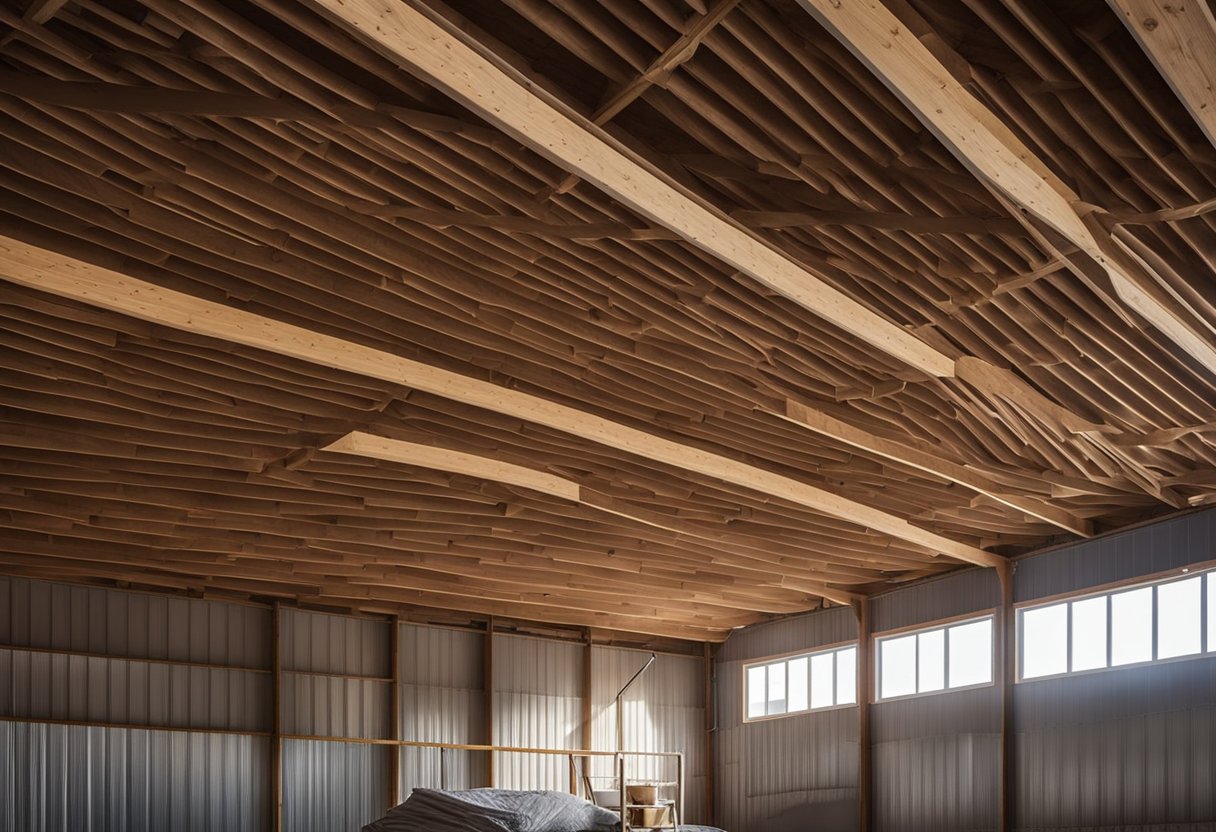
As a responsible builder, I always make sure that my projects comply with the relevant building codes. When it comes to insulating a pole barn ceiling, there are several codes and standards that need to be considered.
The International Energy Conservation Code (IECC) sets the minimum requirements for insulation in residential buildings. The code specifies the R-value of insulation required for different climate zones. The R-value is a measure of the insulation’s ability to resist heat flow. The higher the R-value, the better the insulation.
For example, in zone 5, which includes states like Michigan and Minnesota, the code requires a minimum R-value of 49 for ceiling insulation. In zone 3, which includes states like Texas and Florida, the minimum R-value is 30. It’s important to check the code requirements for your specific location before starting the insulation project.
In addition to the IECC, there may be local building codes that need to be followed. These codes may specify the type of insulation, installation methods, and other requirements. It’s important to check with the local building department to ensure compliance with these codes.
Insulation can also affect the fire safety of a building. Some codes require that the insulation material be fire-resistant or that a fire barrier be installed. This is especially important if the pole barn is used as a garage or workshop where flammable materials may be stored.
To ensure compliance with building codes, I always consult the manufacturer’s installation instructions and follow them carefully. I also make sure to keep records of the insulation installation, including the R-value and type of insulation used. This documentation may be required for building inspections or for insurance purposes.
Overall, compliance with building codes is essential for a safe and energy-efficient pole barn. By following the codes and standards, you can be confident that your project meets the necessary requirements and will provide years of reliable use.
Hiring a Professional vs DIY Insulation
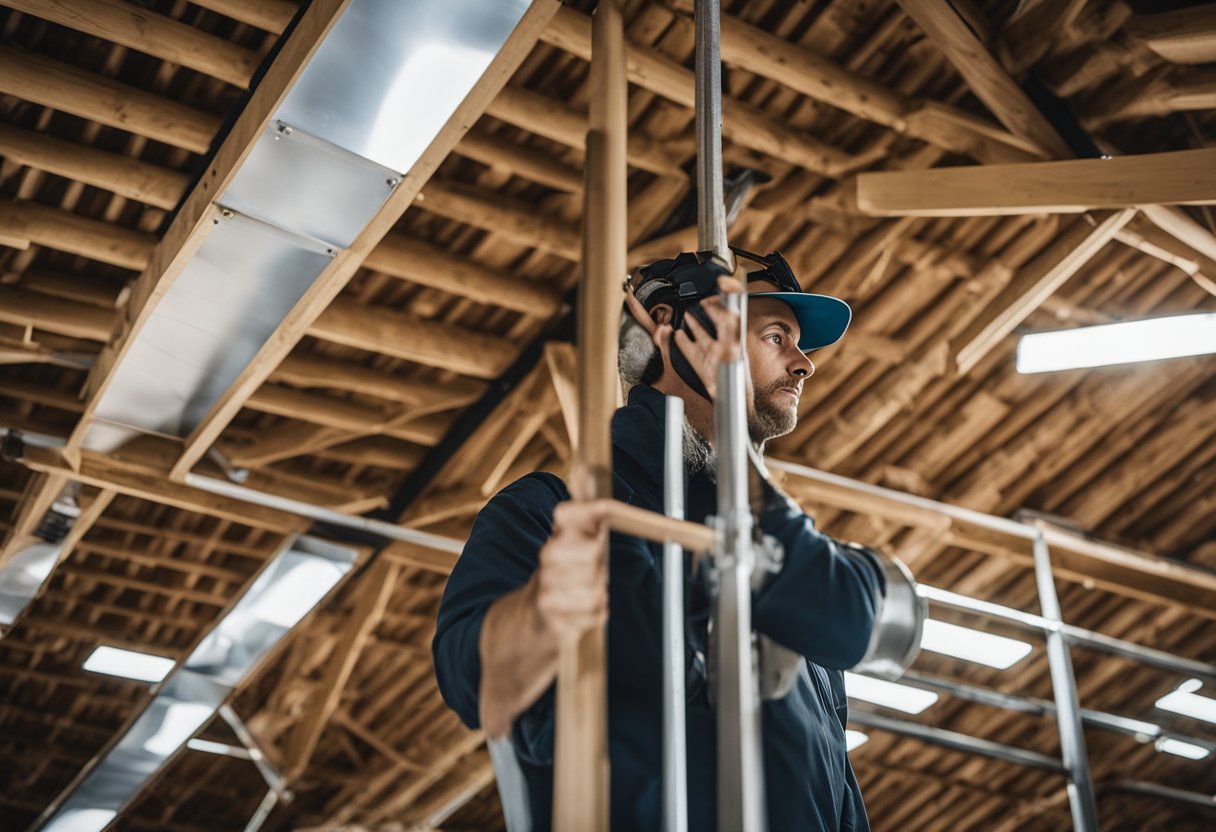
When it comes to insulating a pole barn ceiling, one of the biggest decisions to make is whether to hire a professional or tackle the project yourself. There are pros and cons to both options, so it’s important to carefully consider your situation before making a decision.
Hiring a Professional
Hiring a professional to insulate your pole barn ceiling can be a good option if you don’t have the time, skills, or tools to do the job yourself. A professional contractor will have the experience and knowledge to properly install insulation, which can help prevent potential damage to your building caused by moisture buildup or improper insulation installation. Additionally, a professional contractor may be able to offer a warranty on their work, giving you peace of mind that the job was done correctly.
However, hiring a professional contractor can be more expensive than doing the job yourself. You will need to pay for both labor and materials, which can add up quickly. Additionally, finding a reputable contractor can be a challenge, and you’ll need to do your research to ensure that you’re hiring someone who is qualified and trustworthy.
DIY Insulation
Insulating your pole barn ceiling yourself can be a good option if you have the necessary skills and tools, and want to save money on labor costs. Doing the job yourself can also be a rewarding DIY project, and you’ll have the satisfaction of knowing that you did the work yourself.
However, there are potential risks associated with DIY insulation. If you don’t have the necessary skills or experience, you could accidentally damage your building or install the insulation incorrectly, which could lead to problems down the road. Additionally, if you don’t properly seal the insulation, moisture buildup could occur, which could cause damage to your building.
In summary, whether to hire a professional or tackle the job yourself is a personal decision that depends on your skills, experience, and budget. While hiring a professional can be more expensive, it can offer peace of mind that the job was done correctly. On the other hand, doing the job yourself can save money, but it comes with potential risks.
Conclusion
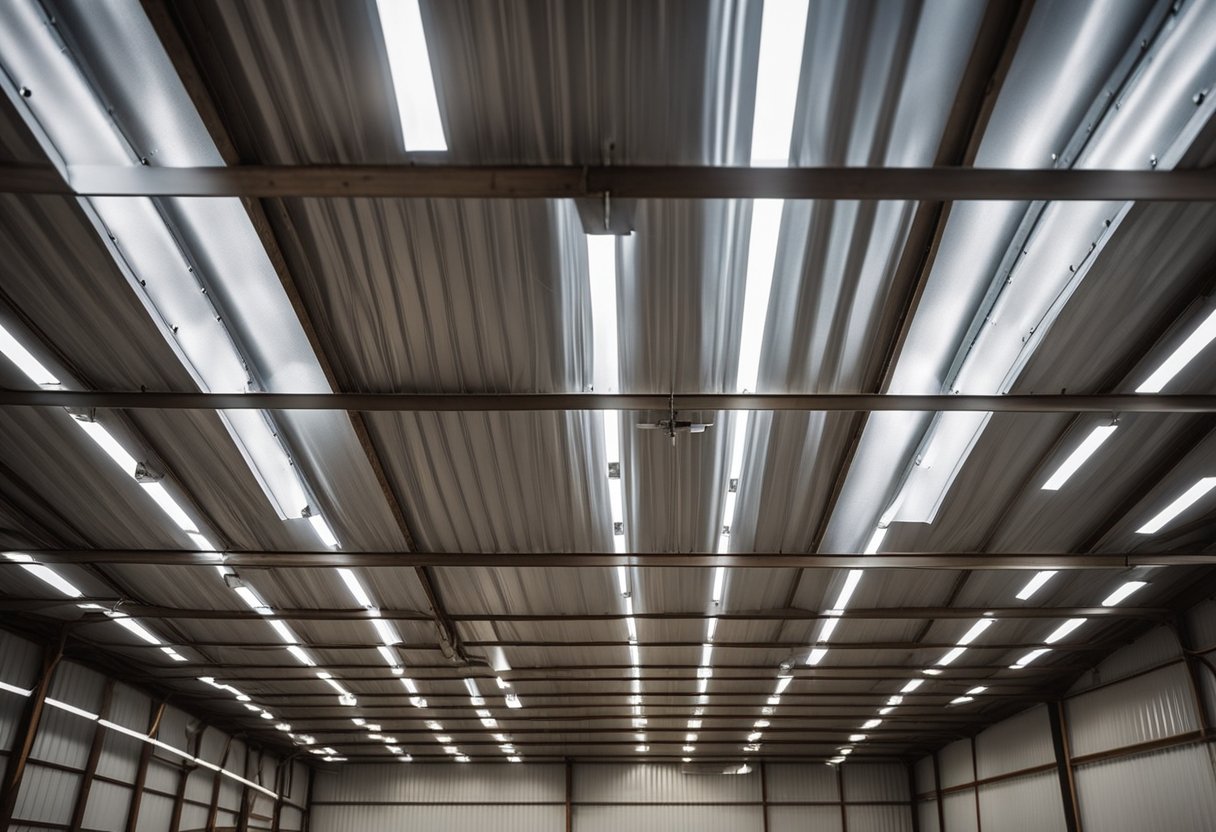
In conclusion, insulating a pole barn ceiling is a great way to ensure that your pole barn stays comfortable all year round with less energy output. By blocking drafts, reducing noise, and helping to control the temperature in your pole barn, you can create a more comfortable and efficient workspace.
When it comes to choosing the right insulation material, there are a few options to consider. Fiberglass batts are a popular choice due to their affordability and ease of installation. Spray foam insulation is another option that provides excellent performance, but it can be more expensive and requires professional installation.
For those looking for a more durable and long-lasting option, rigid foam insulation is a great choice. It can be installed between adjacent vertical joists and between the upper wall beam and the roof cap beam to create a thermal barrier.
It’s important to take precautions when insulating a pole barn ceiling. Be sure to wear protective gear such as gloves, goggles, and a mask to avoid contact with insulation fibers. Additionally, it’s important to ensure that your HVAC system is properly sized and installed to avoid any potential issues with radiant heat.
Overall, insulating your pole barn ceiling is a great investment that can improve the performance and comfort of your workspace. With the right materials and installation techniques, you can create a white, 16 inch square that is both efficient and effective. Whether you choose to use fiberglass batts, spray foam insulation, or rigid foam, be sure to use the right tools such as a hammer and staples to ensure proper installation.
Frequently Asked Questions
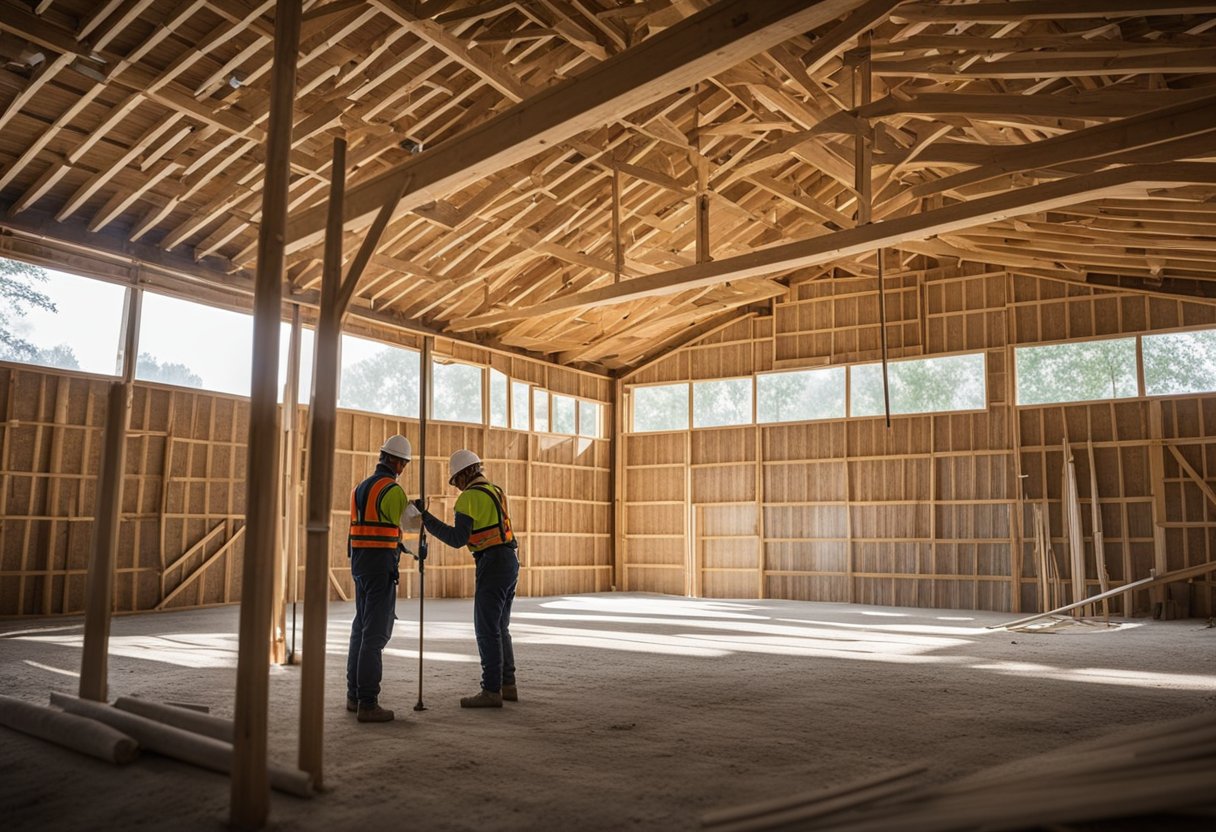
What is the best insulation for pole barn walls?
The best insulation for pole barn walls depends on various factors such as your budget, climate, and personal preference. However, some commonly used insulation materials for pole barn walls include fiberglass batts, spray foam insulation, and blown-in cellulose insulation. Each of these materials has its own advantages and disadvantages, so it’s important to do research and consult with a professional before making a decision.
How do you insulate an existing pole barn roof?
If you have an existing pole barn roof, there are several options for insulating it. One option is to use spray foam insulation, which can be applied directly to the underside of the roof. Another option is to install fiberglass batts or blown-in cellulose insulation between the roof trusses. It’s important to ensure that the insulation is properly installed and that there are no gaps or air leaks.
What is the most efficient way to insulate a pole barn?
The most efficient way to insulate a pole barn depends on various factors such as the climate, the size of the pole barn, and your budget. However, some common methods for insulating a pole barn include using spray foam insulation, fiberglass batts, blown-in cellulose insulation, or rigid foam board insulation. It’s important to ensure that the insulation is properly installed and that there are no gaps or air leaks.
Can you spray foam a pole barn ceiling?
Yes, you can spray foam a pole barn ceiling. Spray foam insulation is a popular option for pole barn ceilings because it provides excellent insulation and helps to prevent air leaks. However, it’s important to ensure that the spray foam is applied correctly and that there are no gaps or air leaks.
Where can I find pole barn insulation near me?
You can find pole barn insulation at your local home improvement stores or online retailers such as Amazon, Home Depot, or Lowes. Additionally, you can consult with a professional insulation contractor who can recommend the best insulation materials for your specific needs.
What are some pole barn ceiling ideas?
Some pole barn ceiling ideas include installing a suspended ceiling, using wood paneling or drywall, or leaving the ceiling exposed and using insulation as a decorative element. It’s important to consider factors such as your budget, the climate, and the intended use of the pole barn when choosing a ceiling design.

Hi, I’m Sal Muller of Tooltrip.com. My DIY experience led me to understand essential power tools for home projects. Tooltrip.com guides enthusiasts and professionals in choosing right tools for any job. I provide concise top tool reviews for easier, efficient DIY.

